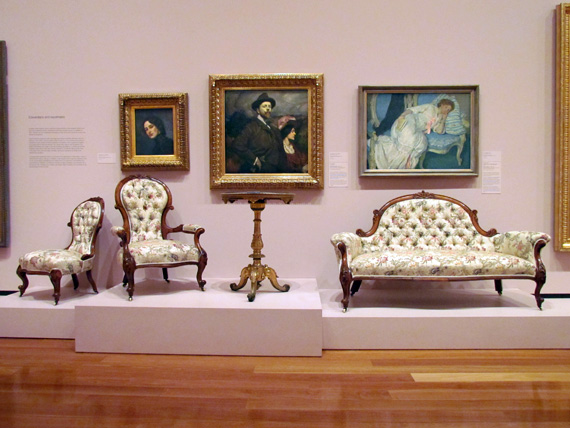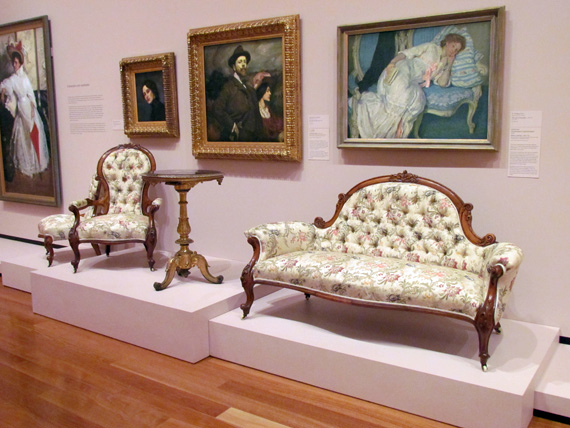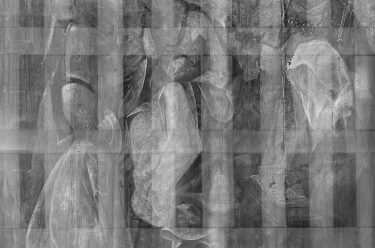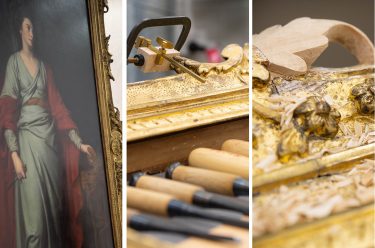
A recent restoration was undertaken over four weeks to a parlour setting from c.1880 – 90s in the Gallery’s Collection, comprising a settee, two grandfather chairs and a grandmother chair. The setting is significant because it was constructed in Queensland from Silky ash (Ehretia acuminata), a native deciduous tree.
My role as Conservation Framer is to maintain the Gallery’s Collection of picture frames and furniture. The rotation of art works in Gallery spaces typically involves the conservation and restoration of original picture frames or the reproduction of historically-accurate ones.
The Parlour setting came into the Collection upholstered in green damask, embroidered with a neoclassical revival pattern — the colour of the fabric and the embroidered pattern were inconsistent with the period of manufacture and a decision was made to re-upholster it.
On initial inspection, each chair appeared to be in good condition, with wear consistent with the age of the setting. There was also what seems to be water damage on all the legs of the chairs, possibly caused by flooding, which would be consistent with living in Brisbane.
Interestingly, one piece of the setting did seem out of place — the second grandfather chair. Why two grandfather chairs? The style of all the chairs was very similar, having buttoned upholstery, a spoon (or wide balloon) back, with carved top rails and arms, however, it was the front legs that were different. The settee, one grandfather chair and the grandmother chairs were supported by carved cabriole legs, while the second grandfather chair had turned front legs.

On closer inspection, it became clear that the second grandfather chair was not part of the Parlour setting. The show-frame (the visible timber not covered by the upholstery) was made from a different species of timber and the cabinet work and carved ornament were of a far superior quality to the other chairs.
A treatment plan was formulated at the same time the replacement fabric was being sourced. The first chair to undergo treatment was the settee. On removing the upholstery, it soon became apparent that the chair-frame (the timber structure covered by the upholstery) was in a far worse condition than the show-frame and it was the upholstery and webbing actually holding the chair together. It was a very crude ‘upholsterers restoration’, in which three-inch nails, screws, metal brackets, tin plates and PVA glue had been used to secure loose and broken joints, causing further deterioration to the condition of the chair. This intervention caused structural damage to the chair-frame and show-frame, splitting joints and damaging dowels.


Once all the upholstery was removed, I was able to identify the construction methods employed in the chairs’ original joinery, which comprised traditional doweled joints adhered with hide glue. I also visually identified the chair-frame as being made of European beech (Fagus sylvatica). European beech is particularly well suited to the manufacture of chairs, however what surprised me was why and how a European timber ended up being used on a piece of furniture made in Queensland during the 1880s — 90s? Further research is required to answer this question. Both the grandfather and grandmother chairs are constructed of the same timbers and were both in a similar condition to the settee and requiring the same restoration treatment.


After what had been revealed beneath the Damask upholstery, a revised treatment proposal was formulated involving fully dismantling each chair, the removal of all non-original hardware such as nails, screws, metal brackets, etc. It also included the removal of PVA glue residue on the joinery, replacement of broken and missing dowels, and the replacement and re-gluing of missing or broken sections of the chair frame with the same species of timber. The adhesive for the treatment was traditional cabinet makers’ hide glue.

Intriguingly, the second grandfather chair had even more to reveal than the previous chairs. On removal of the non-original upholstery on the right armrest, fragments of what have been identified as the original fabric remained. Analysis of the fabric was conducted and it has been identified as a black silk/cotton-based satin furnishing-style fabric, commonly used in the nineteenth century. With this information, an appropriate fabric was selected that matched as closely as possible to the original, in both colour and style. The original black fabric, linen and stuffing (horse hair) has been labelled, catalogued and kept in storage for future reference.

The second grandfather chair frame is made from European beech, like the parlour setting, and the show-frame, from visual identification, is European walnut (Juglans regia) — microscopic identification is required to verify this. Construction methods and the carving employed on this chair were far superior to the others, indicating that it may have been made in Europe. Structurally, the chair was in original condition and the only intervention required was the dismantlement and re-gluing of the front legs and rail.
You can view the Parlour setting in the Australian Collection at the Queensland Art Gallery. What do you think of the restoration and exhibit?




A very nice restoration – thank you for taking the time to share it with us. I was surprised in the difference in quality between the chair-frame and the show-frame prior to restoration, as well as the crude nature of previous attempts. How long has the gallery had these pieces and when do you think the original “upholsterers restoration” was performed?
Hi Clinton. Thanks for your interest. The ‘Parlour setting’ was bequeathed to the Gallery in 1983 by Mrs Mabel Dorothy Archer. As there is no documentation when the previous restoration and reupholstery was performed, I would only be speculating but I would guess circa 1960 -1970’s. Robert
Thanks for the information, Really useful to know about all these Salon chair blog in a single place.